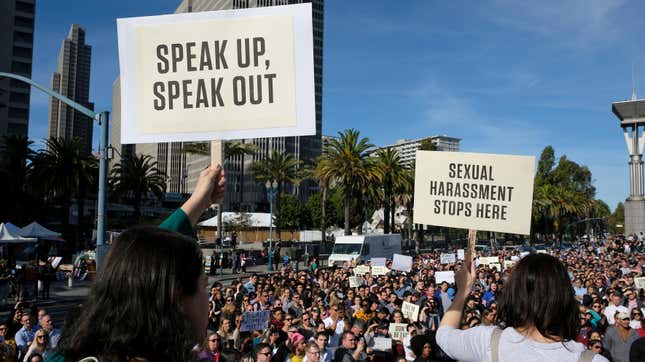
Shortly after Google staffers engaged in the largest mass walkout at any tech firm in the United States, the company quietly lobbied the National Labor Relations Board in the hopes it would roll back a decision that safeguarded the only way protesters were able to organize that action as quickly as they did: email. Unfortunately, Google’s hope has become a reality.
In a 3-1 decision split down party lines, the Trump administration’s work-hostile NLRB today overturned Purple Communications, a critical ruling which found that “employees who have been given access to the employer’s email system in the course of their work are entitled to use the system to engage in statutorily protected discussions about their terms and conditions of employment while on nonworking time.” The short version: In the same way it’s unlawful to restrict workers from talking about organizing out loud, email was kosher, too. Well, no longer.
“In today’s world of work, where people at the same firm often communicate solely over email, this decision severely hamstrings the rights of workers to organize. It is a straitjacket of sorts,” Veena Dubal an associate professor of law, and University of California, Hastings, told Gizmodo via Twitter DM. The ruling also applies retroactively to pending cases, Bloomberg’s Hassan Ali Kanu pointed out. “To the extent Google did not previously have a rule restricting use of work email for organizing, the Google workers have not violated any internal rule,” Dubal wrote, though lack of clarity around internal policies has been a major sticking point in the instance of its five contentious firings of employees, all of whom have filed complaints with this same NLRB.
The board’s argument, in brief, states that work email is the property of the employer. While yes, technically, so is a factory floor, the NLRB claims that email “creates a virtual space in which the distinction between working and nonworking areas is meaningless.” As such, there is no “line separating working from nonworking time” as it pertains to work email; therefore, companies may forbid any use of work email for organizing, regardless of when it happens.
NLRB further argues that restricting the use of company email in this way doesn’t place an unreasonable restriction on workers’ ability to organize. “[O]ral solicitation and face-to-face literature distribution provide more than ‘adequate avenues of communication.’ [...] There is no reason to believe that these methods of communication have ceased to be available in the typical workplace, and almost all employees continue to report to such workplaces on a regular basis,” the board writes.
There’s a reasonable chance you read the above paragraph on an employer-provided computer, and most “talking” you do with your colleagues throughout the day is via email or a chat app, in which case the preposterousness of this argument is self-evident.
Worse still, the ruling does not limit itself to email alone. By presenting a case against employee organizing that makes use of “email and other information-technology (IT) resources,” this NLRB holds a broad interpretation that could apply to workplace chat apps like Slack, or devices like company cell phones and laptops.
Still, it’s crucial to remember that Purple Communications only dates back to halfway through the second Obama term, and there’s a possibility this ban on email-based organizing would be overturned in the future. “The NLRB has flip-flopped 3 times in the last 12 years on this issue,” Dubal wrote. “My guess is that under a Democratic administration, the NLRB would flip flop again.” But there’s no sugar-coating it: With tech workers beginning to build grassroots power in their industry, this ruling could not have come at a worse time.